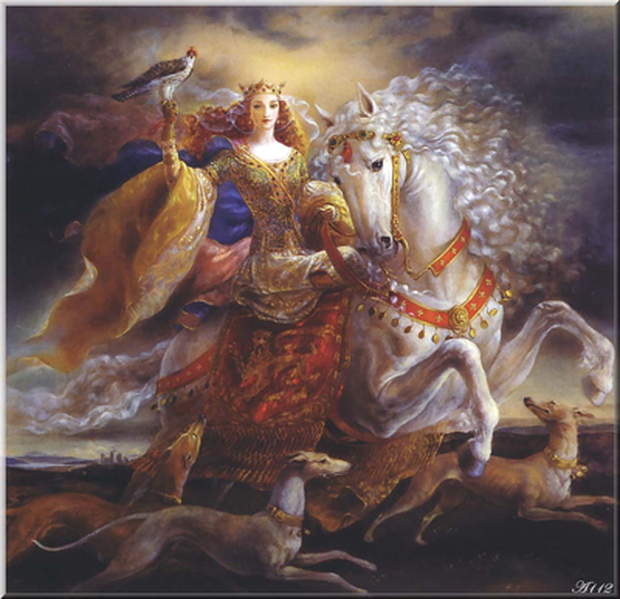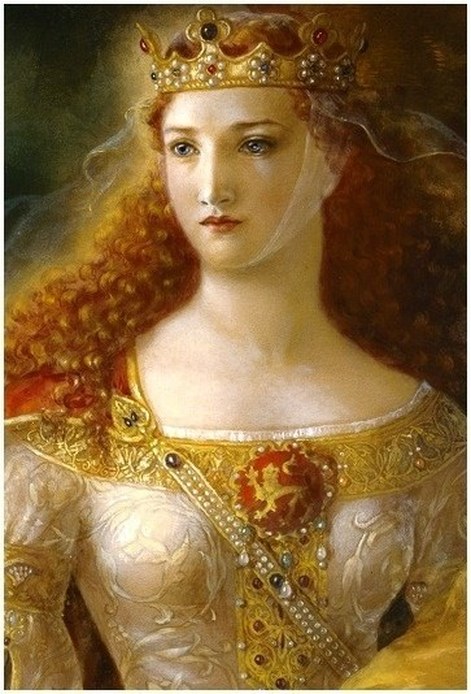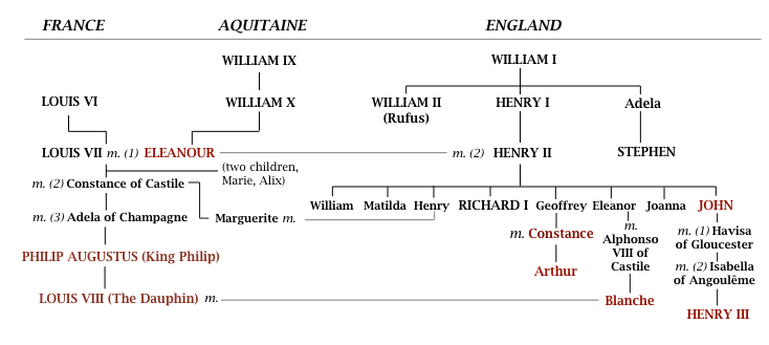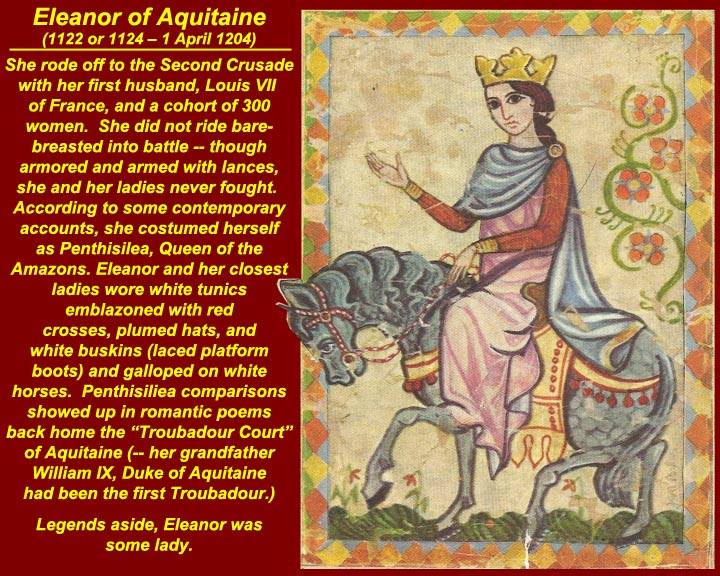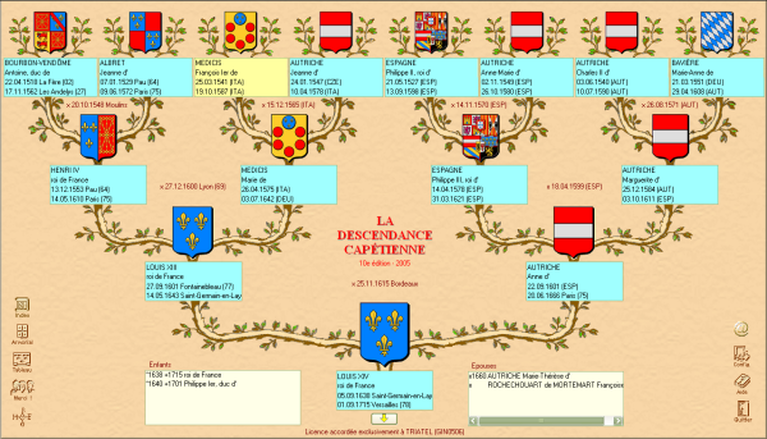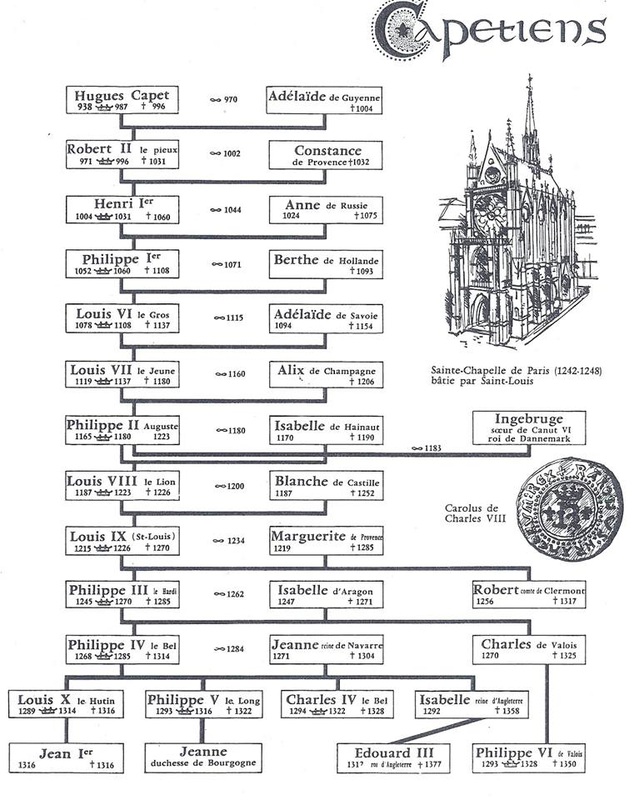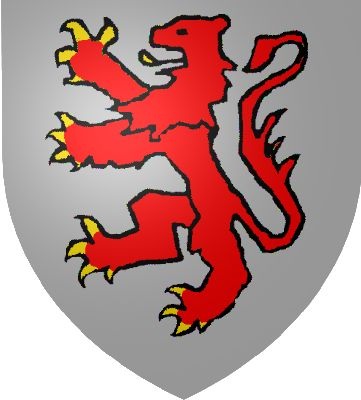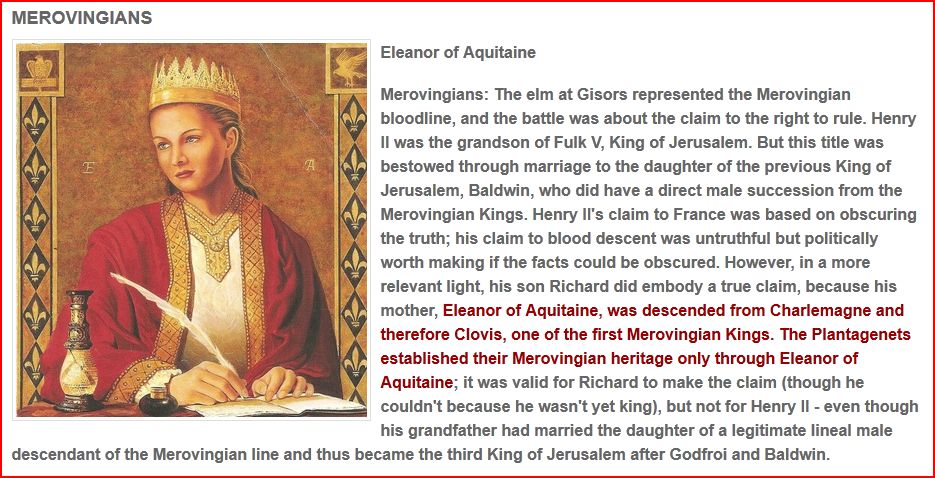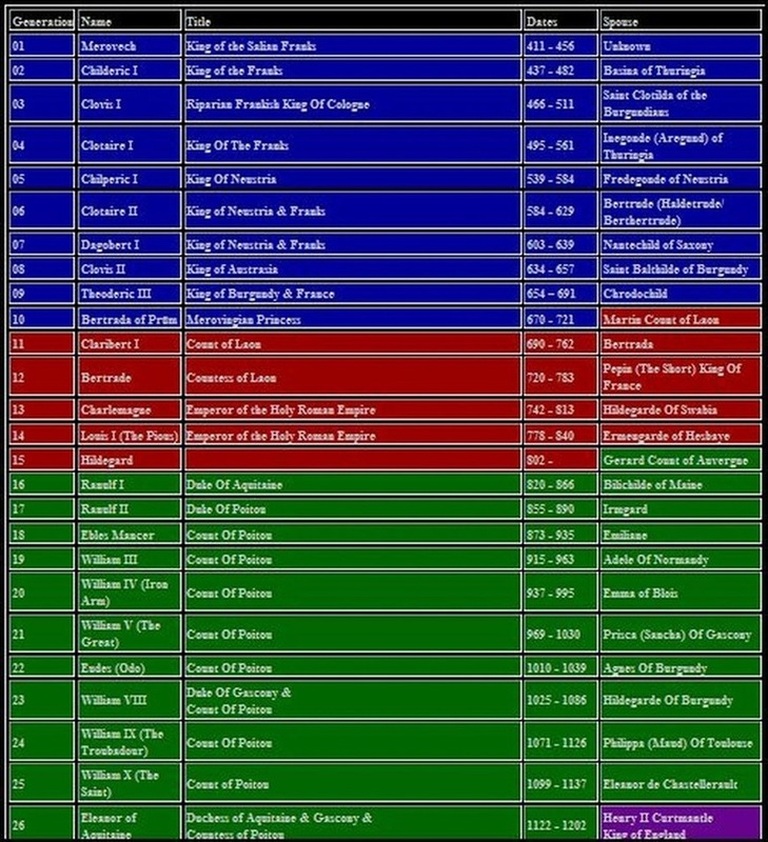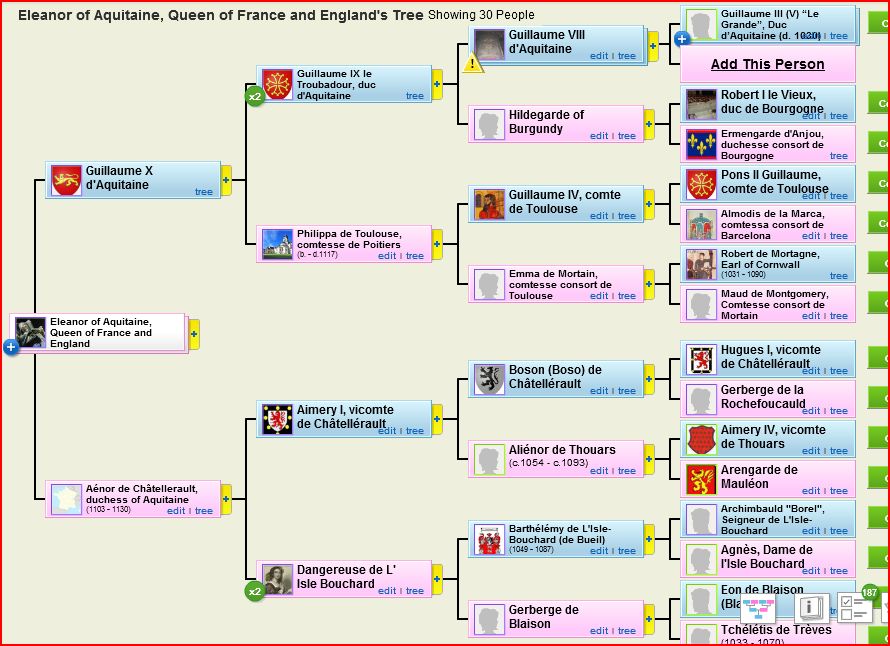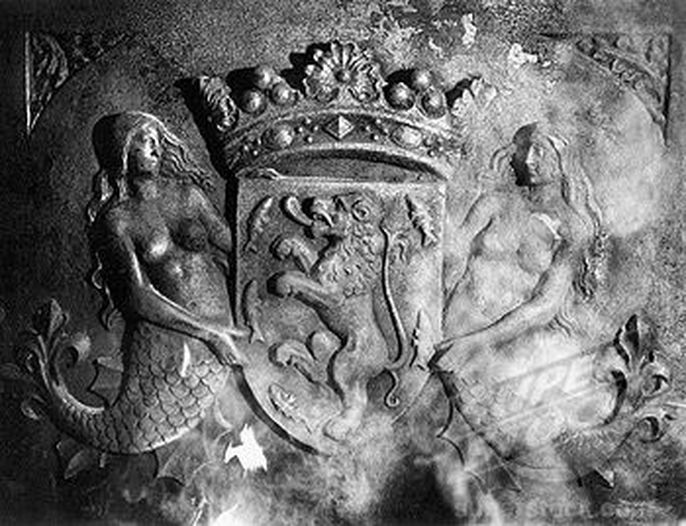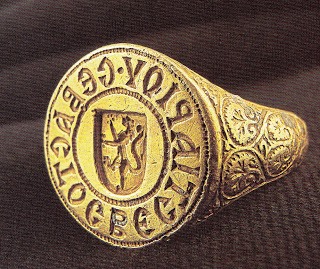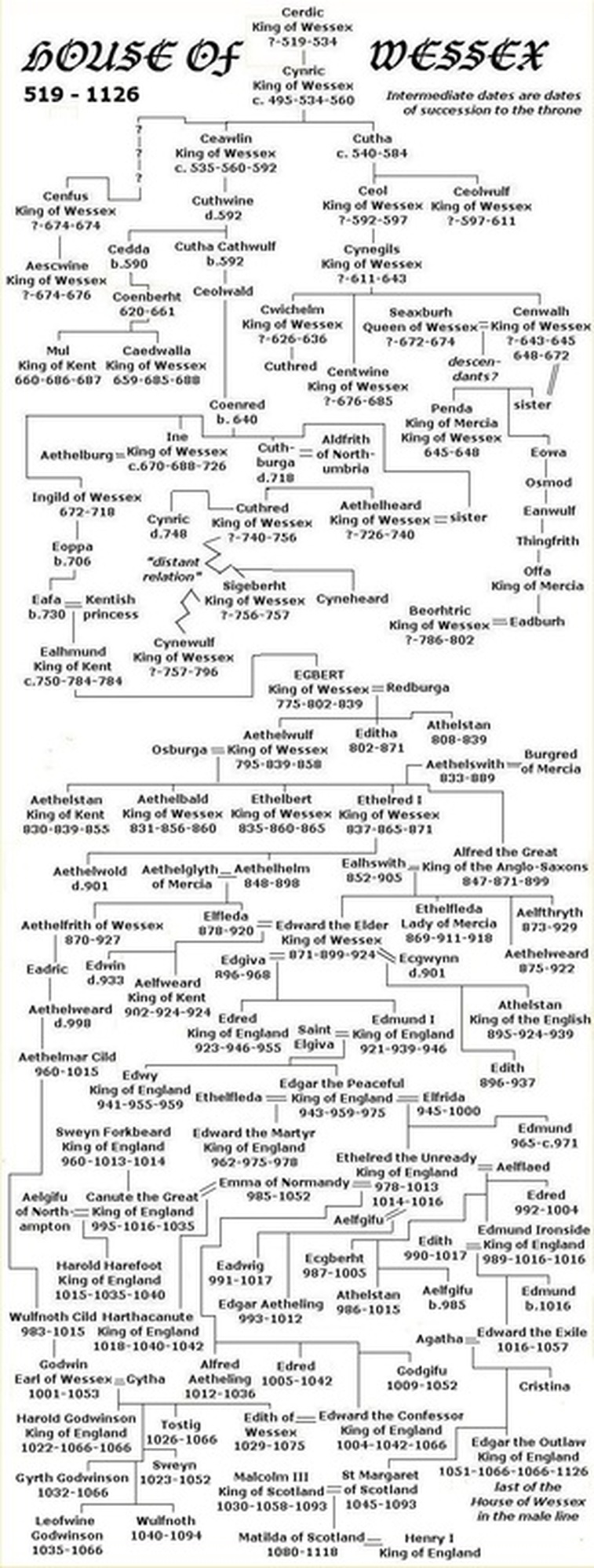Eleanor of Aquitaine Gateway
Royal Houses of Capet & Plantagenet.
Reine Alienor d'Aquitaine's first marriage:
The king of France, known as Louis the Fat, had been gravely ill, suffering from a bout of (dysentery) from which he seemed unlikely to recover. Despite his immense obesity and impending mortality, Louis remained clear-minded. To his concerns regarding his new heir (Louis VII), who had been destined for the monastic life of a younger son (the former heir, Philip, died from a riding accident), was added joy over the death of one of his most powerful vassals – and the availability of the most desirable duchy in France. Presenting a solemn and dignified manner to the grieving Aquitainian messengers, he became overjoyed when they departed, stammering in delight. Rather than act as guardian to the duchess and duchy, he decided that he would marry the duchess to his heir and bring Aquitaine under the control of the French Crown, thereby greatly increasing the power and prominence of France and its ruling family, the Capets. Within hours Louis had arranged for his 17 year-old son, Prince Louis, to be married to Alienor, with Abbot Suger in charge of the wedding arrangements. Prince Louis was sent to Bordeaux with an escort of 500 knights, as well as Abbot Suger, Theobald II, Count of Champagne, and Count Ralph.
On 25 July 1137, Louis and Alienor were married in the Cathedral of Saint-André in Bordeaux by the Archbishop of Bordeaux. Immediately after the wedding, the couple was enthroned as Duke and Duchess of Aquitaine. However, there was a catch: the land would remain independent of France until Alienor's oldest son became both King of the Franks and Duke of Aquitaine. Thus, her holdings would not be merged with France until the next generation. As a wedding present she gave Louis a rock crystal vase currently on display at the Louvre. Louis gave the vase to the Saint Denis Basilica. This vase is the only object connected with Alienor d'Aquitaine that still survives.
Louis's tenure as Count of Poitou and Duke of Aquitaine and Gascony lasted only few days. Although he had been invested as such on 8 August 1137, a messenger gave him the news that Louis VI had died of dysentery on 1 August while he and his wife were making a tour of the provinces. Thus he became King Louis VII of France. He and Alienor were anointed and crowned King and Queen of the Franks on Christmas Day of the same year.
(credit Wikipedia)
The king of France, known as Louis the Fat, had been gravely ill, suffering from a bout of (dysentery) from which he seemed unlikely to recover. Despite his immense obesity and impending mortality, Louis remained clear-minded. To his concerns regarding his new heir (Louis VII), who had been destined for the monastic life of a younger son (the former heir, Philip, died from a riding accident), was added joy over the death of one of his most powerful vassals – and the availability of the most desirable duchy in France. Presenting a solemn and dignified manner to the grieving Aquitainian messengers, he became overjoyed when they departed, stammering in delight. Rather than act as guardian to the duchess and duchy, he decided that he would marry the duchess to his heir and bring Aquitaine under the control of the French Crown, thereby greatly increasing the power and prominence of France and its ruling family, the Capets. Within hours Louis had arranged for his 17 year-old son, Prince Louis, to be married to Alienor, with Abbot Suger in charge of the wedding arrangements. Prince Louis was sent to Bordeaux with an escort of 500 knights, as well as Abbot Suger, Theobald II, Count of Champagne, and Count Ralph.
On 25 July 1137, Louis and Alienor were married in the Cathedral of Saint-André in Bordeaux by the Archbishop of Bordeaux. Immediately after the wedding, the couple was enthroned as Duke and Duchess of Aquitaine. However, there was a catch: the land would remain independent of France until Alienor's oldest son became both King of the Franks and Duke of Aquitaine. Thus, her holdings would not be merged with France until the next generation. As a wedding present she gave Louis a rock crystal vase currently on display at the Louvre. Louis gave the vase to the Saint Denis Basilica. This vase is the only object connected with Alienor d'Aquitaine that still survives.
Louis's tenure as Count of Poitou and Duke of Aquitaine and Gascony lasted only few days. Although he had been invested as such on 8 August 1137, a messenger gave him the news that Louis VI had died of dysentery on 1 August while he and his wife were making a tour of the provinces. Thus he became King Louis VII of France. He and Alienor were anointed and crowned King and Queen of the Franks on Christmas Day of the same year.
(credit Wikipedia)
The kings of the 'Third Race':
This royal dynasty reigned in France from 987 to 1792. These rulers was once called "the Kings of the third race", as they followed after the Merovingian and Carolingian Royal Dynasties. Direct Capetians ruled until 1328. Collateral branches followed them. The Capetian Valois 1328 in 1498; the Valois-Orleans from 1498 to 1515; the Valois Angoulême from 1515 to 1589; the Bourbons from 1589 to 1792. The nickname of Capet, made his first appearance around 1030 in the Chronicle of Ademar de Chabanne, it then applies to the father of Hugues Capet, Duke Hugues Ier. He describes Hugues Capet only at the beginning of the 12th century and the "Capetian" term appears for the first time at the chronicler English Diketo Raoul (+ 1202). The revolutionaries gave it derisively to Louis XVI dethroned ("the Citizen Capet") and his family. The nickname comes from the word cappa, "yoke", and means the holder of a small coat. Perhaps he hinting at the Abbey screed, Hugh and his father being secular Abbots of numerous abbeys. In the 12th century, the screed has become a hood or hat, Hugues Capet was regarded as "the man with the hat", and the legend, based on this false etymology, was born, that he had not been able or wanted to receive the Crown. The three branches of the Capetian dynasty who reigned in France ended the same way....
(credit histoiredefrance.com)
This royal dynasty reigned in France from 987 to 1792. These rulers was once called "the Kings of the third race", as they followed after the Merovingian and Carolingian Royal Dynasties. Direct Capetians ruled until 1328. Collateral branches followed them. The Capetian Valois 1328 in 1498; the Valois-Orleans from 1498 to 1515; the Valois Angoulême from 1515 to 1589; the Bourbons from 1589 to 1792. The nickname of Capet, made his first appearance around 1030 in the Chronicle of Ademar de Chabanne, it then applies to the father of Hugues Capet, Duke Hugues Ier. He describes Hugues Capet only at the beginning of the 12th century and the "Capetian" term appears for the first time at the chronicler English Diketo Raoul (+ 1202). The revolutionaries gave it derisively to Louis XVI dethroned ("the Citizen Capet") and his family. The nickname comes from the word cappa, "yoke", and means the holder of a small coat. Perhaps he hinting at the Abbey screed, Hugh and his father being secular Abbots of numerous abbeys. In the 12th century, the screed has become a hood or hat, Hugues Capet was regarded as "the man with the hat", and the legend, based on this false etymology, was born, that he had not been able or wanted to receive the Crown. The three branches of the Capetian dynasty who reigned in France ended the same way....
(credit histoiredefrance.com)
Queen Eleanor of Aquitaine's second marriage:
Regarding, Henry II, Eleanor was related to him more closely than she had been to Louis; they were cousins to the third degree through their common ancestor, Ermengarde of Anjou (wife of Robert I, Duke of Burgundy and Geoffrey, Count of Gâtinais), and were also descended from King Robert II of France. A marriage between Henry and Eleanor's daughter Marie had indeed been declared impossible due to their status as third cousins once removed. One of Eleanor's rumoured lovers had been Henry's own father, Geoffrey V, Count of Anjou, who had advised his son to avoid any involvement with her.
On 25 October 1154, Eleanor's second husband became King of England. Eleanor was crowned Queen of England by the Archbishop of Canterbury on 19 December 1154. It may be, however, that she was not anointed on this occasion, because she had already been anointed in 1137.
Over the next thirteen years, she bore Henry five sons and three daughters: William, Henry, Richard, Geoffrey, John, Matilda, Eleanor, and Joan. John Speed, in his 1611 work History of Great Britain, mentions the possibility that Eleanor had a son named Philip, who died young. His sources no longer exist, and he alone mentions this birth.
(credit Wikipedia)
Regarding, Henry II, Eleanor was related to him more closely than she had been to Louis; they were cousins to the third degree through their common ancestor, Ermengarde of Anjou (wife of Robert I, Duke of Burgundy and Geoffrey, Count of Gâtinais), and were also descended from King Robert II of France. A marriage between Henry and Eleanor's daughter Marie had indeed been declared impossible due to their status as third cousins once removed. One of Eleanor's rumoured lovers had been Henry's own father, Geoffrey V, Count of Anjou, who had advised his son to avoid any involvement with her.
On 25 October 1154, Eleanor's second husband became King of England. Eleanor was crowned Queen of England by the Archbishop of Canterbury on 19 December 1154. It may be, however, that she was not anointed on this occasion, because she had already been anointed in 1137.
Over the next thirteen years, she bore Henry five sons and three daughters: William, Henry, Richard, Geoffrey, John, Matilda, Eleanor, and Joan. John Speed, in his 1611 work History of Great Britain, mentions the possibility that Eleanor had a son named Philip, who died young. His sources no longer exist, and he alone mentions this birth.
(credit Wikipedia)
The Merovigians were a dynasty of Frankish kings, descended, according to tradition, from Merovech, chief of the Salian Franks , whose son was Childeric I and whose grandson was Clovis I , the founder of the Frankish monarchy. Merovingian kings followed Frankish custom in dividing the patrimony. After the death (511) of Clovis I, the kingdom was divided among his descendants into various kingdoms, which later became known as Austrasia , Neustria , and Burgundy . These kingdoms, whose borders were constantly shifting, were often combined; for brief periods, they were all united in a single realm under Clotaire I (558-61), Clotaire II (613-23), and Dagobert I (629-39). The rule of the Merovingians before Dagobert I was disturbed by chronic warfare among aristocrats and rivals for power, notably between Queen Brunhilda of Austrasia and Queen Fredegunde of Neustria. Dagobert I was the last active ruler; his descendants were called the rois fainéants, or idle kings. They were entirely subject to their mayors of the palace, the Carolingians , who became the nominal as well as the actual rulers of the Franks when Pepin the Short deposed (751) the last Merovingian king, Childeric III.
Merovingian Descent Eleanor of Aquitaine:
Merovingian Dynasty (Blue); Carolingian Dynasty (Red); House of Poitiers (Green);
Plantagenet Dynasty (Purple) > English Peerage > Commoners
Merovingian Dynasty (Blue); Carolingian Dynasty (Red); House of Poitiers (Green);
Plantagenet Dynasty (Purple) > English Peerage > Commoners
Plantagenet
(According to the Legend of the Plantagenet Monarchs of England)
The Plantagenet bloodline is part of the ancestry of the present-day English monarchs and many of the descendants of the early American colonists. I originally ran across the story of the Plantaganets and the legend of our shapeshifting ancestor, Melusine, while researching my own genealogy.
The Plantagenets of England were the first of a line of French monarchs, whose ascent to the English throne would mark the beginning of numerous conflicts between England and France, two countries that historically did not look favorably upon each other.
But, the English of the 12th century were horrified at the prospect of Henry II on the throne, not just because he was half French, but because he was from the House of Plantagenet, which according to legend is not an entirely human bloodline.
The original Plantagenet lines derived from the House of Anjou and the House of the Merovingians. The Merovingian kings were known for their long, reddish-blonde hair and their symbol is the fleur-de-lis, which is now sometimes seen as a symbol of France.
While these ideas may seem more like Medieval fairy-tale, than historical fact, the reality is, that the idea of this bloodline being magical, mystical and a little terrifying to some has a basis in the history of the Plantagents and they are derived from the story of an important, legendary ancestor named Melusina or Melusine.
Melusina was a shape-shifting, amphibious woman who was part serpent or fish and part human. She is depicted with two-fish tails, sometimes the tail of a serpent and wings, however, Melusina was not entirely unique, but one of a species; her mother and all of her family line were not entirely human.
There are numerous French legends about Melusina, but the basic story is that a King of the Merovingian Dynasty married a beautiful woman. She and the king had three children, all of whom were monstrous in appearance, one having long claws and another having a great tusk growing out of his mouth.
Melusine built a marvelous castle as a gift for her husband. When the two married, Melusine had made him promise never to visit her when she took her bath on Saturday. The king agreed. But, one day, he broke his promise and caught sight of her bathing, with her long serpent tail flowing over the side of the bathtub.
Enraged, he accused her of poisoning his bloodline. She turned into a flying serpent or dragon and left, never to return.
This story was well-known in France and England when the first Plantagenet King assumed the throne in the 12th century. All of the kings and queens in England, France, Germany and other Western European nations carry this hybrid bloodline in their veins, as well.
(credit A. Giovanni)
Dragon Bloodlines...The Royal Houses of Merovee...Plantagenet... and Lusignan:
(Note: The Plantagenet Lion icon...Gold ring, Mistra, with Lusignan emblem.)
The first Angevin dynasty was known from the 12th century as the Plantagenet dynasty through the House of Anjou which produced King Henry II and subsequent kings:
"Geoffrey Plante Genest, count of Anjou and Maine was the father of king Henry II of England and, amongst others, Hamelyn (Plantagenet), Warren earl of Surrey (London). The first evidence for the Pl(a/e)nte name in England is found in 1219, just after the times of Henry II's son, the lecherous king John.
"In 1200, king John married Isabella of Angouleme in Aquitaine who subsequently married Hugh de Lusignan, the most prominent baron of Aquitaine. In 1247, John (Plantagenet) (de Warenne) married Alice Lusignan (de Brien) and English resentments of favouritism towards the `foreign' Lusignans led on to the Baron's revolt in England, leading to the capture of king Henry III at Lewes (1264), though the king was freed by John (Plantagenet) (de Warenne) at Evesham (1265)." - 950
"The Plantagenets were themselves a junior branch of the House of Anjou, whose senior branch was the House of Vere [whose] ancestry was jointly Pictish and Merovingian descending from the ancient Grail House of Scythia." - 248:8
"According to the 'Prieuré documents' the lords of Anjou-Plantagenet family were thus allied to the Merovingian bloodline. And the name of Plantagenet may even have been intended to echo 'Plant-ard' or Plantard.'" - 31:302
According to Fritz Springmeier's Top Thirteen Illuminati Bloodlines, "The original start of the Prieuré de Sion appears to have been the idea of a number of powerful bloodlines, and included various descendants of the Merovingians, including the House of Lorraine, the House of Guise, the Medicis, Sforzas, the Estes, the Gonzagas, and the St. Clairs (Sinclairs). The Medicis are tied to the Black Nobility.
"From the beginning the Prieuré de Sion has been committed to Hermetic Magic... René d' Anjou, a descendant of the Merovingians persuaded Cosimo de Medici to establish in c. 1444 a non-church library at San Marco where Plato, Pythagorean works, and books on Hermetic Magic were translated. Up until this time, the Catholic church had control of all the libraries. It was from Cosimo de Medici's library that the spark of Greek and Egyptian teachings set off what developed into the Renaissance, which was a revival of humanism and the occult. It appears that during the Middle Ages, witchcraft and the mystery religions had seriously dissolved to the point that these modes of thought had to be relearned from the ancient writings. Interestingly, the Middle Ages when witchcraft and paganism were dissolving have been branded the 'Dark Ages' by the establishment, and inaccurately painted as a time when learning went out." - 77:79
The Merovingian families which ruled France, England and Germany included the Hapsburg-Lorraine dynasty which, in the twentieth century, played a major role in the formation of the European Union.
"Prominent in the Wars of Religion was the noble French family of de Guise... [T]hey disputed the legitimacy of the Valois succession, and claimed their own right to the throne by virtue of descent from the Emperor Charlemagne through the House of Lorraine." - 29:307
(credit watch.pair.com)
(Note: The Plantagenet Lion icon...Gold ring, Mistra, with Lusignan emblem.)
The first Angevin dynasty was known from the 12th century as the Plantagenet dynasty through the House of Anjou which produced King Henry II and subsequent kings:
"Geoffrey Plante Genest, count of Anjou and Maine was the father of king Henry II of England and, amongst others, Hamelyn (Plantagenet), Warren earl of Surrey (London). The first evidence for the Pl(a/e)nte name in England is found in 1219, just after the times of Henry II's son, the lecherous king John.
"In 1200, king John married Isabella of Angouleme in Aquitaine who subsequently married Hugh de Lusignan, the most prominent baron of Aquitaine. In 1247, John (Plantagenet) (de Warenne) married Alice Lusignan (de Brien) and English resentments of favouritism towards the `foreign' Lusignans led on to the Baron's revolt in England, leading to the capture of king Henry III at Lewes (1264), though the king was freed by John (Plantagenet) (de Warenne) at Evesham (1265)." - 950
"The Plantagenets were themselves a junior branch of the House of Anjou, whose senior branch was the House of Vere [whose] ancestry was jointly Pictish and Merovingian descending from the ancient Grail House of Scythia." - 248:8
"According to the 'Prieuré documents' the lords of Anjou-Plantagenet family were thus allied to the Merovingian bloodline. And the name of Plantagenet may even have been intended to echo 'Plant-ard' or Plantard.'" - 31:302
According to Fritz Springmeier's Top Thirteen Illuminati Bloodlines, "The original start of the Prieuré de Sion appears to have been the idea of a number of powerful bloodlines, and included various descendants of the Merovingians, including the House of Lorraine, the House of Guise, the Medicis, Sforzas, the Estes, the Gonzagas, and the St. Clairs (Sinclairs). The Medicis are tied to the Black Nobility.
"From the beginning the Prieuré de Sion has been committed to Hermetic Magic... René d' Anjou, a descendant of the Merovingians persuaded Cosimo de Medici to establish in c. 1444 a non-church library at San Marco where Plato, Pythagorean works, and books on Hermetic Magic were translated. Up until this time, the Catholic church had control of all the libraries. It was from Cosimo de Medici's library that the spark of Greek and Egyptian teachings set off what developed into the Renaissance, which was a revival of humanism and the occult. It appears that during the Middle Ages, witchcraft and the mystery religions had seriously dissolved to the point that these modes of thought had to be relearned from the ancient writings. Interestingly, the Middle Ages when witchcraft and paganism were dissolving have been branded the 'Dark Ages' by the establishment, and inaccurately painted as a time when learning went out." - 77:79
The Merovingian families which ruled France, England and Germany included the Hapsburg-Lorraine dynasty which, in the twentieth century, played a major role in the formation of the European Union.
"Prominent in the Wars of Religion was the noble French family of de Guise... [T]hey disputed the legitimacy of the Valois succession, and claimed their own right to the throne by virtue of descent from the Emperor Charlemagne through the House of Lorraine." - 29:307
(credit watch.pair.com)
(c)2013; All Rights Reserved, Iona Miller, Sangreality Trust
[email protected]
Fair Use Notice
This site contains copyrighted material the use of which has not always been specifically authorized by the copyright owner. We are making such material available in our efforts to advance understanding of environmental, political, human rights, economic, democracy, scientific, and social justice issues, etc. We believe this constitutes a 'fair use' of any such copyrighted material as provided for in section 107 of the US Copyright Law. In accordance with Title 17 U.S.C. Section 107, the material on this site is distributed without profit to those who have expressed a prior interest in receiving the included information for research and educational purposes. If you wish to use copyrighted material from this site for purposes of your own that go beyond 'fair use', you must obtain permission from the copyright owner.
[email protected]
Fair Use Notice
This site contains copyrighted material the use of which has not always been specifically authorized by the copyright owner. We are making such material available in our efforts to advance understanding of environmental, political, human rights, economic, democracy, scientific, and social justice issues, etc. We believe this constitutes a 'fair use' of any such copyrighted material as provided for in section 107 of the US Copyright Law. In accordance with Title 17 U.S.C. Section 107, the material on this site is distributed without profit to those who have expressed a prior interest in receiving the included information for research and educational purposes. If you wish to use copyrighted material from this site for purposes of your own that go beyond 'fair use', you must obtain permission from the copyright owner.
